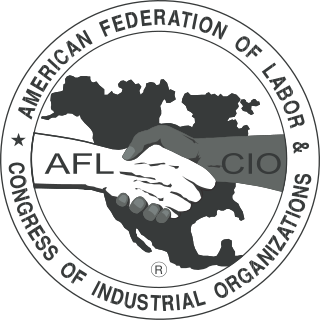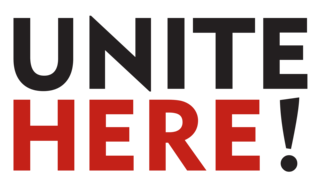Jay Mazur (born May 21, 1932) is an American labor leader. He was the last president of the International Ladies' Garment Workers' Union (ILGWU), serving from 1986 to 1995, and the first president of the Union of Needletrades, Industrial and Textile Employees (UNITE), serving from 1995 to 2001.
Jay Mazur was born in East Bronx, NY on May 21, 1932, the son of Simon Mazur, a cloak maker and union man who emigrated from Poland to New York in 19; his mother, Mollie, died when he was 11, leaving his father to raise four children - twin boys and two older girls.
After graduating from high school in 1951, Mazur began work in the Health and Welfare Department of New York City's dressmaker's Local 22. In 1955, Mazur entered the ILGWU's Training Institute, a 1-year intensive program to prepare students for staff appointments in the ILGWU, and was assigned as an organizer in the Upper South Department and the New England Region. After graduation in 1956, Mazur was assigned to Local 40, where he became Director of Organization and Education. In 1959, Mazur began working for Local 23, which later merged with Local 25 to become Local 23-25. Mazur began work as an organizer for the local in 1959, was elected as Assistant Manager in 1964, and manager in 1973.
Mazur became a Vice-President of the International in 1977. During his tenure in Local 23 and 23-25, Mazur was involved in major organizing efforts, as well as significant social and educational programs for union members. He was manager of Local 23-25 in 1982, when thousands of workers in New York City's Chinatown went on strike to win a fair contract. Under his leadership, Local 23-25 established an Immigration Project to assist members and their families with legal and related immigration issues. While working for the union, Mazur earned his an undergraduate degree in Personnel and Labor Studies from City College of New York, and later a master's degree in Labor Studies from Rutgers University.
In 1983, Mazur was elected to the International's leadership as Secretary-Treasurer, and in 1986, he was elected to succeed Sol Chaikin as President of the ILGWU. During his tenure as President, Mazur led major campaigns to stem the decline of garment manufacturing in the United States. This included the creation of the ILGWU's Professional and Clerical Employees (PACE) Division and the Metro Organizing Department, the expansion of the Immigration Project to be national in scope, and the establishment of workers centers in major metropolitan centers. Mazur served on the Executive Councils of the AFL-CIO, and the AFL-CIO's Industrial Union Department of the AFL-CIO; in addition to his work in domestic and international labor federations, he has also served on numerous foundation boards and government commissions.
Under Mazur's leadership, the ILGWU merged with the Amalgamated Clothing and Textile Workers of America to form the Union of Needletrades, Industrial and Textile Employees (UNITE) in 1995. He served as the first president of UNITE, from 1995 until his retirement in 2001. In addition to his work for the ILGWU and UNITE, Mazur served on the Executive Council of the AFL-CIO, as well as the Industrial Union Department of the AFL-CIO. He is a member of the Executive Committee of the Jewish Labor Committee and President of the 21st Century ILGWU Heritage Fund.

The American Federation of Labor and Congress of Industrial Organizations (AFL–CIO) is the largest federation of unions in the United States. It is made up of 60 national and international unions, together representing more than 12 million active and retired workers. The AFL–CIO engages in substantial political spending and activism, typically in support of progressive and pro-labor policies.
The Communist Party USA and its allies played an important role in the United States labor movement, particularly in the 1930s and 1940s, but wasn't successful in either in bringing the labor movement around to its agenda of fighting for socialism and full workers' control over industry, or in converting their influence in any particular union into membership gains for the Party. The CP has had only negligible influence in labor since its supporters' defeat in internal union political battles in the aftermath of World War II and the CIO's expulsion of the unions in which they held the most influence in 1950. After the expulsion of the Communists, organized labor in the United States began a steady decline.

John Joseph Sweeney was an American labor leader who served as president of the AFL–CIO from 1995 to 2009.
Craft unionism refers to a model of trade unionism in which workers are organised based on the particular craft or trade in which they work. It contrasts with industrial unionism, in which all workers in the same industry are organized into the same union, regardless of differences in skill.

Sidney Hillman was an American labor leader. He was the head of the Amalgamated Clothing Workers of America and was a key figure in the founding of the Congress of Industrial Organizations and in marshaling labor's support for President Franklin D. Roosevelt and the New Deal coalition of the Democratic Party.

David Dubinsky was a Belarusian-born American labor leader and politician. He served as president of the International Ladies Garment Workers Union (ILGWU) between 1932 and 1966, took part in the creation of the CIO, and was one of the founders of the American Labor Party and the Liberal Party of New York.

UNITE HERE is a labor union in the United States and Canada with roughly 300,000 active members. The union's members work predominantly in the hotel, food service, laundry, warehouse, and casino gaming industries. The union was formed in 2004 by the merger of Union of Needletrades, Industrial, and Textile Employees (UNITE) and Hotel Employees and Restaurant Employees Union (HERE).
The Union of Needletrades, Industrial, and Textile Employees was a labor union in the United States. In 2004, UNITE merged with the Hotel Employees and Restaurant Employees Union (HERE) to form UNITE HERE.

The International Ladies' Garment Workers' Union (ILGWU), whose members were employed in the women's clothing industry, was once one of the largest labor unions in the United States, one of the first US unions to have a primarily female membership, and a key player in the labor history of the 1920s and 1930s. The union, generally referred to as the "ILGWU" or the "ILG", merged with the Amalgamated Clothing and Textile Workers Union in the 1990s to form the Union of Needletrades, Industrial and Textile Employees (UNITE). UNITE merged with the Hotel Employees and Restaurant Employees Union (HERE) in 2004 to create a new union known as UNITE HERE. The two unions that formed UNITE in 1995 represented 250,000 workers between them, down from the ILGWU's peak membership of 450,000 in 1969.
Amalgamated Clothing Workers of America (ACWA) was a United States labor union known for its support for "social unionism" and progressive political causes. Led by Sidney Hillman for its first thirty years, it helped found the Congress of Industrial Organizations. It merged with the Textile Workers Union of America (TWUA) in 1976 to form the Amalgamated Clothing and Textile Workers Union (ACTWU), which merged with the International Ladies' Garment Workers' Union in 1995 to create the Union of Needletrades, Industrial and Textile Employees (UNITE). UNITE merged in 2004 with the Hotel Employees and Restaurant Employees Union (HERE) in 2004 to create a new union known as UNITE HERE. After a bitter internal dispute in 2009, the majority of the UNITE side of the union, along with some of the disgruntled HERE locals left UNITE HERE, and formed a new union named Workers United, led by former UNITE president Bruce Raynor.
The Hotel Employees and Restaurant Employees Union (HERE) was a United States labor union representing workers of the hospitality industry, formed in 1890. In 2004, HERE merged with the Union of Needletrades, Industrial, and Textile Employees (UNITE) to form UNITE HERE. HERE notably organized the staff of Yale University in 1984. Other major employers that contracted with this union included Harrah's, Caesars Palace, Wynn Resorts, Hilton Hotels, Hyatt, and Walt Disney World. HERE was affiliated with the AFL–CIO.

Workers United is an American and Canadian labor union which represents about 86,000 workers in the apparel, textile, commercial laundry, distribution, food service, hospitality, fitness and non-profit industries. It was established in its current form in 2009 and is affiliated to the Service Employees International Union (SEIU).
Labor unions in the United States, since their early beginnings, have held various viewpoints on immigration. There were differences among the labor unions and occasionally opposition to contemporary majority opinions and public policies.

Charles S. "Sasha" Zimmerman (1896–1983) was an American socialist activist and trade union leader, who was an associate of Jay Lovestone. Zimmerman had a career spanning five decades as an official of the International Ladies Garment Workers Union. During the early 1970s, Zimmerman and Bayard Rustin were national Co-Chairmen the Socialist Party of America and the Social Democrats USA.
Louis Stulberg (1901–1977) was president of the International Ladies' Garment Workers' Union from 1966 to 1975.
Nicholas Bonanno was an organizer, regional director, and Vice-President of the International Ladies' Garment Workers' Union (ILGWU).
John W. Wilhelm was elected president/hospitality industry of UNITE HERE at the union's founding convention on July 9, 2004. He was elected president on June 30, 2009, at the union's first constitutional convention.

The Congress of Industrial Organizations (CIO) was a federation of unions that organized workers in industrial unions in the United States and Canada from 1935 to 1955. Originally created in 1935 as a committee within the American Federation of Labor (AFL) by John L. Lewis, a leader of the United Mine Workers (UMW), and called the Committee for Industrial Organization. Its name was changed in 1938 when it broke away from the AFL. It focused on organizing unskilled workers, who had been ignored by most of the AFL unions.
May Ying Chen is an American labor organizer and advocate for immigrant workers. Before retiring in 2009, she was an officer and founding member of the AFL–CIO's Asian Pacific American Labor Alliance (APALA), and the International Vice President of UNITE HERE.
Katie Quan is a senior fellow at the UC Berkeley Center for Labor Research and Education, a former chair of the center, and a former labor organizer. In 1982, she was one of the organizers of the historic garment workers' strike in New York City's Chinatown.